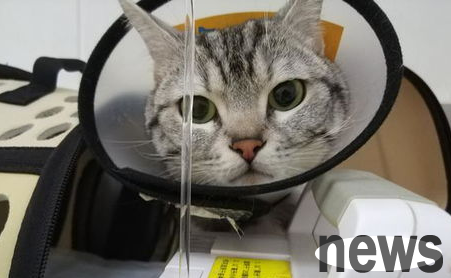Playing cats, bald? Frequent hair loss in recent years | A 9-year-old girl in Xuzhou became bald and blistered after petting her cat for a week!
A few days ago,
The Dermatology Department of Xu Medical Affiliated Hospital admitted a special case:
After a week of raising a cat, a 9-year-old girl
began to lose hair on the top of her head.
There were many bald patches,
and many small pustules.
It was scary to see...
A 9-year-old girl had pustules all over her head and was bald. It was actually the cat that caused the trouble

According to Jiang Guan, chief physician of the Department of Dermatology of Xu Medical Affiliated Hospital, a key clinical specialty in Jiangsu Province and a key medical discipline in Xuzhou City, when the little girl came to the hospital, there were many small pustules on her scalp, and the purulent secretions were stuck together with her hair. It looked like scabs on the entire scalp.
There were many bald patches on the top of the head, as well as many small pustules.
After asking about the medical history and examination, it was found that
the culprit of the skin disease on the little sister's head was actually the cat at home.
It turned out that the little girl had a dog at home, and she had just adopted a cat a while ago. The girl and the cat were very close, and they often held her in her arms, and even slept with the kitten.
Director Jiang Guan explained that the little girl was infected by cat fungi due to long-term close contact with kittens. "Because children are young, their skin is still relatively thin and tender, and they are prone to fungal infections."
According to reports, this fungal infection appears on children's scalp, which we call tinea capitis. The clinical manifestations of some tinea capitis patients will be tinea capitis.
In recent years,
the number of pets kept at home has increased,
resulting in an increase in the disease.
Xu Medical Affiliated Hospital has treated many similar cases.
Bathe pets frequently to prevent the source of infection.
What should I do if I suffer from tinea capitis? It must be early detection and early treatment, and the earlier the treatment, the better the effect! Early treatment is simple and convenient, and generally leaves no sequelae.
It is understood that there are some symptoms of early infection with tinea capitis - the first is itching of the scalp.
Director Jiang Guan said that the fungus does not take long from the initial infection to hair loss, it only takes about a month, so families with cats and dogs must pay attention to it and take precautions.
Be sure to prevent it from the source
In addition to taking precautions for animals, pay attention to cleanliness and hygiene. Director Jiang Guan of the Xu Medical Affiliated Hospital also reminded everyone that people should also do a good job of cleaning and prevention after coming into contact with animals. You can use some medicinal lotions to wash your hair, wash your hands, etc., so that the prevention effect will be better.
If you don’t have pets at home,
do you not need to
take special precautions against tinea capitis?
Wrong!
If you don’t keep pets at home, you should also pay attention to preventing infection.
Director Jiang Guan said that you can get tinea capitis from contact with sick animals such as cats and dogs, but you can also get tinea capitis from contact with people with tinea capitis, such as mixing bedding, wearing other people’s hats, sharing hairdressing tools, etc.
Therefore, once you find that your child is always scratching his head with his hands, has dandruff on his scalp, or even has patches of hair loss, parents must not think that it is ordinary alopecia areata or "dandruff" and ignore it.
Here
we also let parents identify
the true appearance of various tinea capitis
Clinical manifestations:
According to bacterial species and host response, tinea capitis is divided into white tinea, black spot tinea, yellow tinea and purulent tinea.
Vitiligo: Mainly seen in children, the skin lesions initially appear as large scaly mother spots, followed by smaller scattered satellite-shaped purple spots around them. It can heal on its own, leaving almost no scars after recovery. Hair is easily broken 2-3mm away from the scalp.
Black spot tinea: It is more common in children, but adults can also be infected. The typical skin lesions are numerous small scaly patches. The lesions are broken off as soon as they grow out, and the stumps become black spots. Small scars may remain after healing.
Yellow tinea and purulent tinea: It is more common in children. If not treated promptly, it may develop into purulent tinea. Typical skin lesions are disc-shaped yellow scabs the size of soybeans to eggs, with hairs visible in the center. Atrophic scars will remain after healing. The affected areas are dry and dull, and permanent bald patches may form in the lesions.
Auxiliary examination:
Fungal microscopy. This examination method is to scrape the skin flakes from the affected area with a blade, and stain it under a microscope to observe whether there is fungus. This examination is economical, convenient, fast, and almost painless. If necessary, culture of fungi and secretions is required to further improve the diagnosis and treatment plan.
Treatment:
According to the type and severity of the patient's condition, after diagnosis, oral and/or topical antifungal drug treatment is conducted under the guidance of a doctor.
Director Jiang Guan here reminds everyone that you must not use topical or oral drugs before diagnosis. This may cause various complications and aggravation of the condition due to irregular treatment, and increase the patient's pain.
Preventive measures:
1. Cut off the transmission route: Properly isolate bedding, remove clothes and hats, wash and iron, etc.
2. Eliminate the source of infection: cure patients and pets that have been infected by fungi.
3. Protect susceptible groups: The common susceptible group for tinea capitis is children, but it can also infect adults. For children, parents and schools must do a good job of hygiene and keep personal items for personal use. Parents should also pay attention to developing good living habits for their children, wash their hair frequently, and pay attention to scalp hygiene. Do not exchange hats, towels or other personal items with other children. When you go to a barber shop to get a haircut, try to ask the barber to disinfect the scissors and combs used.
Director Jiang Guan of the Xu Medical Affiliated Hospital reminds everyone that if you accidentally contract tinea capitis, don’t be too nervous. Find out as early as possible and go to a regular hospital for fungal microscopy to confirm the diagnosis. Don’t conceal the disease and avoid medical treatment, which delays the condition. With early treatment, most prognosis is still very promising.




